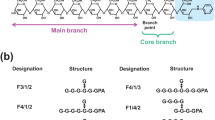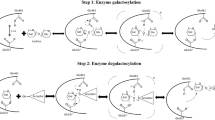Abstract
Bacillus circulans was able to produce extracellular levansucrase using sucrose as carbon source optimally at 35°C. The enzymic synthesis of levan and fructo-oligosaccharides was studied using a 50% ethanol fraction of crude extract. The molecular weight of the synthesized levan was markedly affected by sucrose concentration, the molecular weight of levan decreased with increased sucrose concentration up to 32% whereby fructo-oligosaccharides were isolated. Temperature and the reaction time clearly affected the conversion of fructose to levan with molecular weight values ranging from 10 to 38 kDa. Identification of levan indicated that fructose was the building unit of the levan obtained. Thermal and pH stabilities of B. circulans levansucrase could be improved by enzyme glycosylation using sodium metaperiodate treatment. Chemical modification provides additional points of attachment of the enzyme to the support which offered the modified enzyme greater stabilization than did the free enzyme. The modified enzyme exhibited thermal tolerance up to 50°C, where it retained 88.25% of its activity, while the free enzyme only retained 64.55% of its original activity. The half-life significantly increased from 130 min for the free enzyme to 347 min for the modified enzyme at 50°C, however, it increased from 103 min for the free enzyme to 210 min for the modified enzyme at 60°C. Other properties i.e., the response to some metal ions as well as the ability to convert higher substrate levels and tolerance to an extension of the reaction periods were also improved upon modification. Obviously, the results obtained outlined the conditions leading to the formation of important high or low molecular weight or levan and fructo-oligosaccharides suitable for different industrial applications.





Similar content being viewed by others
References
Abd el-Naby MA (1999) Stabilization of cellobiase by covalent coupling to soluble polysaccharide. Microbiol Res 154:213–218
Belghith H, Song KB, Kim CH, Rhee SK (1996) Optimal conditions for levan formation by an overexpressed recombinant levansucrase. Biotechnol Lett 18:467–472. doi:10.1007/BF00143472
Ben Ammar Y, Matsubara T, Iizuka M, Limpaseni T, Ponsawasdi P (2001) Some properties of levansucrase of Bacillus natto stabilized with periodate oxidized yeast glucomannan. Enzym Microb Technol 30:875–882. doi:10.1016/S0141-0229(02)00039-X
Drevon GF (2002) Enzyme immobilization into polymers and coatings. Ph.D. Thesis, University of Pittsburgh
Block RJ, Durum EL, Zweig G (1955) A manual of paper chromatography and paper electrophoresis. Academic, New York, p 127
Fernandez M, Villalonga ML, Fragoso A, Cao R, Villalonga R (2002) Stabilization of α a-Chymotrypsin by modification with β-cyclodextrin derivatives. Biotechnol Appl Biochem 36:235–239. doi:10.1042/BA20020056
Flachner B, Bnumbauer A, Reczey K (1999) Stabilization of β-glucosidase in Aspergillus phoenicis QM 329 pellets. Enzym Microb Technol 24:362–367. doi:10.1016/S0141-0229(98)00133-1
Gottschalk N, Jaenicke R (1991) Authenticity and reconstitution of immobilized enzymes: characterization, denaturization and renaturation of glucoamylase. Biotechnol Appl Biochem 14:324–335
Gross M, Ceier G, Rudolph K, Cieder K (1992) Levan and levansucrase synthesized by the fire blight pathogen Erwinia amylovora. Physiol Mol Plant Pathol 40:371–381. doi:10.1016/0885-5765(92)90029-U
Kaboli H, Reilly RJ (1980) Immobilization and properties of Lecuconostoc mesenteroides. Biotechnol Bioeng 22:1055–1069. doi:10.1002/bit.260220513
Kasapis S, Morris E, Gross M, Rudolph K (1994) Solution polysaccharide from Pseudomonas syringe phaseolicola and its possible primary role as a blocker of recognition during pathogenesis. Carbohydr Polym 23:55–69. doi:10.1016/0144-8617(94)90090-6
Kim MG, Seo JW, Song KS, Kim CH, Chung BH, Ki-Rhee S (1998) Levan and fructosyl derivatives formation by a recombinant levansucrase from Rahnella aquatilis. Biotechnol Lett 20:333–336. doi:10.1023/A:1005310926399
Langsford ML, Gikes NR, Singh B, Moser B, Miller RC, Warren RAJ (1987) Glycosylation of bacterial cellulases prevents proteolytic cleavage between functional domains. FEBS Lett 225(1–2):163–167
Lazie M, Veljkovic V, Vuxetic JI, Vrvic MM (1993) Effect of pH and aeration on dextran production by Leuconstoc mesenteroides. Enzym Microb Tech 15:334–338. doi:10.1016/0141-0229(93)90160-4
Marx S, Koning S, Hartmeier W (1999) Synthesis of fructo-oligosaccharides by native, and immobilized levansucrase from Zymomonas mobilis. Thirteenth forum for applied Biotechnology, Gent. Proceedings. Part I, vol 642, pp 246–251
Masarova J, Mislovicova D, Gemeiner P, Michalkova E (2001) Stability enhancement of Escherichia coli penicillin G amylase by glycosylation with yeast mannan. Biotechnol Appl Biochem 34:127–133. doi:10.1042/BA20010037
Pedrosa C, De Felice FG, Trisciuzzi C, Ferrerira ST (2000) Selective neoglycosylation increases the structural stability of vicilin, the 75 storage globulin from pea seeds. Arch Biochem Biophys 382:203–210. doi:10.1006/abbi.2000.2024
Sacha A, Hijum V, Bonthing K, Mare J, Maarel V, Dijkhuzen L (2001) Purification of novel fructosyltranferase from Lactobacillusreuteri strains 121 and characterization of the levan produced. FEMS Microbiol Lett 205:323–328
Wong SS, Loseizicz M, Wong LIC (1993) Protein chemical cross-linking, implications for protein stabilization. In: Himmel EM, Georgiou G (eds) Biocatalyst design for stability and specificity. American Chemical Society, Washington, DC, pp 266–282
Yamamoto Y, Takahashi Y, Kawano M, Iizuka M, Matsumotg T, Saek S, Yamaguchi H (1999) In vitro digestibility and fermentability of levan and its hypocholesterotemic effects in rats. J Nutr Biochem 10:13–18. doi:10.1016/S0955-2863(98)00077-1
Yannase H, Fukushi H, Ueda N, Maeda Y, Toyoda A, Tonomura K (1992) Cloning sequencing and characterization of the intracellular invertase gene from Zymomonas mobilis. Agric Biol Chem 55:1383–1390
Yun JW (1996) Fructo-oligosaccharides occurrence, preparation and application. Enzym Microb Technol 19:107–117. doi:10.1016/0141-0229(95)00188-3
Acknowledgments
This work is a part of a research project entitled: “Application of the recent approaches to improve the activity and the stability of some microbial enzymes of economical importance”, financed by the Academy of Scientific Research and Technology, Egypt.
Author information
Authors and Affiliations
Corresponding author
Rights and permissions
About this article
Cite this article
El-Refai, H.A., Abdel-Fattah, A.F. & Mostafa, F.A. Enzymic synthesis of levan and fructo-oligosaccharides by Bacillus circulans and improvement of levansucrase stability by carbohydrate coupling. World J Microbiol Biotechnol 25, 821–827 (2009). https://doi.org/10.1007/s11274-009-9957-x
Received:
Accepted:
Published:
Issue Date:
DOI: https://doi.org/10.1007/s11274-009-9957-x




